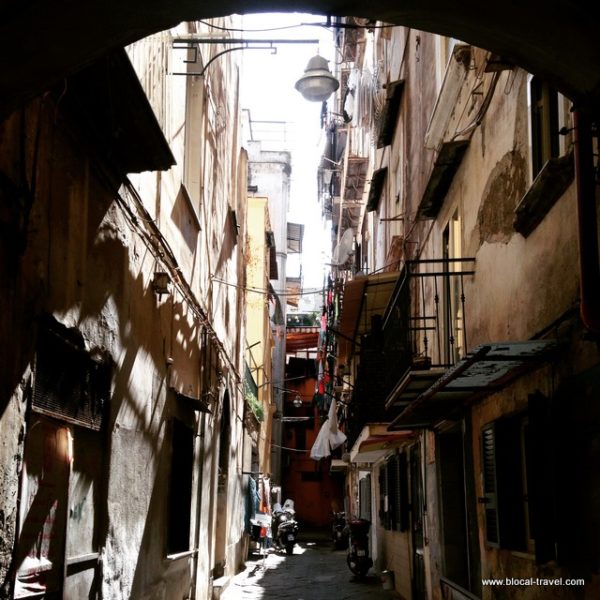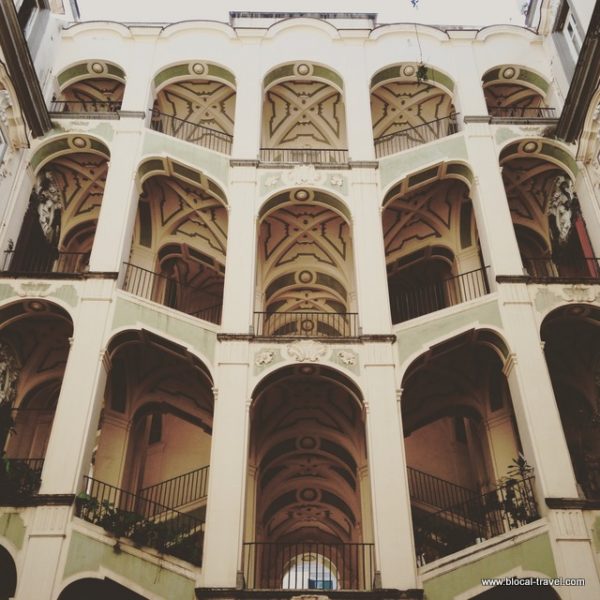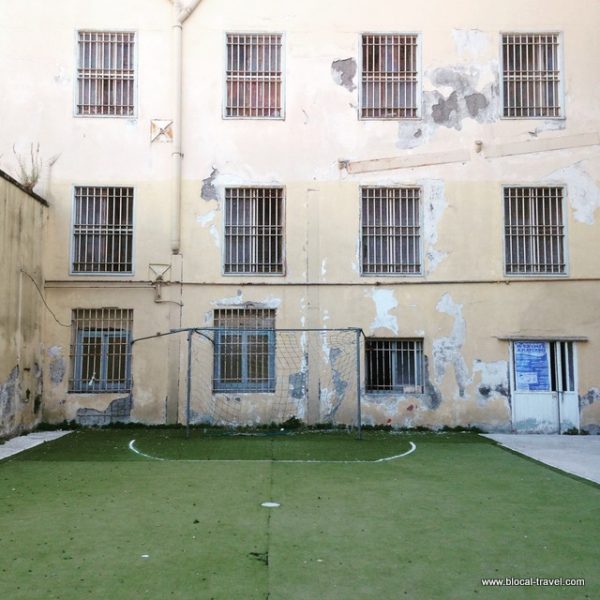Do you remember when I stated that I’m always up for a trip to Naples?
I’ve been feeling pretty moody lately, as this summer began with an upsetting issue that, let’s just say, forced me to redefine some stuff in my life.
Anyway, the point is that, as I needed something to cheer me up, I opted for that cheerfulness and enthusiasm for life that only Neapolitans have (and, well, for their great food too!).
Naples off the beaten path > CIMITERO DELLE FONTANELLE
My first stop was the Cimitero delle Fontanelle, an ossuary in the Sanità neighbourhood, which happens to be my favourite area of Naples.
Rione Sanità rises on the slope of Capodimonte hill and it is built on Neapolitan yellow tuff, a soft stone that originated 12,000 years ago after a volcanic eruption and is still visible inside the tuff caves in the area, which served the needs of the city until the last century. When, in the 16th century, the plague arrived in Naples and it claimed 250,000 victims (out of a population of 400,000 inhabitants) one of these caves, the Cave of Fontanelle, was turned into a cemetery. During the decades it kept accommodating victims of earthquakes, volcanic eruptions and other catastrophes.
The cemetery was then abandoned until 1872, when all the skulls and bones were arranged as we see them today.
Coming from the bright sunshine and almost 40°, the first things that struck me as I entered the cave were the darkness and the cool. Then I began walking past the several skulls and bones piled against the walls, which are illuminated only by feeble lights.
There was some water dripping from the top of the cave and the sound of it made the experience even creepier, in a ‘memento mori’ and ‘time is passing by’ kind of feeling . Suddenly, someone activated a carillon that was at the entrance of the cave, next to the first piles of bones; if the visit wasn’t creepy enough, it really became so then!
From the Cemetery of Fontanelle I went down the hill as far as the core of the Sanità neighbourhood, which is one of the most ancient neighbourhoods in Naples.
There I found a lively food market, the ubiquitous laundry hanging in the sun, a maze of narrow streets and several beautiful courtyards, which are at the same time shabby and elegant.
The best known courtyard in the hood is the one of the Spanish Palazzo, which is characterized by a well-designed staircase with an open double flight of stairs.
But, honestly, they all are very charming!
The hood itself is one of the most genuine corners in Naples, where you can glimpse the most authentic soul of the city. A lot of neo-realistic movies, which shaped our idea of Naples, were shot in this hood and this is also the hood where Totò was born.
Naples off the beaten path > SANTA MARIA ALLA SANITA’
At the core of the Sanità neighbourhood there is the Baroque-style church of Santa Maria alla Sanità (aka San Vincenzo alla Sanità), which was built at the beginning of the 17th century over the Catacombs of Saint Gaudioso. Unfortunately it was too late to visit the catacombs, which are accessible only in the morning, but I did admire the paintings inside the church, which show different artistic currents from mannerist to classicist, baroque and contemporary.
Then I visited the beautiful elliptical cloister whose peculiarity -besides the decorations by Giovanni Battista Di Pino depicting the history of the Dominican order- is that it incorporates a pillar of the Sanità bridge, over which cars pass.
Another peculiarity of this church is that it includes a hostel, called ‘Il Monacone’, from where you can access the dome of the church and enjoy the beautiful view. Speaking of the dome, when I was walking over the Sanità bridge, I couldn’t help taking this picture from which you can see how it is beautifully tiled with yellow and green majolica, a kind of covering which I have also found along the Amalfi coast.
Naples off the beaten path > CATACOMBS OF SAINT GENNARO
As I didn’t make it to visit the Catacombs of Saint Gaudioso, I went to the nearby Catacombs of Saint Gennaro, which is the largest Christian catacomb complex in southern Italy.
This underground Paleo-Christian burial site decorated with frescoes and mosaics extends over two levels: the original nucleus from the late 2nd and early 3rd century, which was built around the pre-existent lower vestibule, and the upper area, added later, expanded so as to encompass the other two adjacent cemeteries.
In the 5th century the site was consecrated to Saint Gennaro, the patron saint of the city, on the occasion of the entombment there of his remains, which were later removed to the Cathedral of Naples.
I attended a guided tour organized by ‘Cooperativa La Paranza’, a bunch of local youngsters who reopened the site to the public thanks to their enthusiasm and love for their ‘difficult’ neighbourhood.
The tour ended at the Basilica di San Gennaro extra moenia, which was built during the 5th century outside the city walls and subsequently underwent several makeovers, not only shifting from a Paleo-Christian to a Baroque architecture with a twist of Gothic style and Catalan structural design, but also being converted into an hospital for people affected with plague and, later, to a poorhouse.
Naples off the beaten path > Jesopazzo
Back to the sunlight, I kept wandering around Rione Sanità until I reached the neighbouring Rione Materdei. Materdei is another authentic and genuine area of Naples, made of steep streets on which locals keep running way and back with their motor-scooters, wearing no helmets as it is dictated by the Neapolitan fashion.
I was looking for a former mental asylum for prisoners that was shut down in 1978 after the Italian government passed a law suppressing psychiatric hospitals (Basaglia Law) and, after a period of abandonment, recently has been squatted by students and local activists who renamed the place ‘Jesopazzo’ (which means ‘I am crazy’ in local dialect).
I was so lucky to arrive there during their general assembly and so I was able to overhear what the guys at Jesopazzo are up to, and I must admit that they are dealing with a lot of very interesting and challenging projects, ranging from a legal help desk to summer camps for the kids from Materdei, who someone might define ‘needy kids’ given the bad reputation of the neighbourhood.
Naples off the beaten path > Pizzeria Starita
Of course, when in Naples, I couldn’t miss the chance of having a pizza! And so I went to Starita, one of the most ancient pizzerias in Naples, which opened in 1901 in the Materdei neighbourhood. The pastry was soft, that kind of softness that melts in your mouth and makes you droll, making me realize that as much as I can look for a good pizza in Rome, it will never taste as it tastes in Naples. Maybe it’s the water, maybe it is the craftsmanship, but I’m sure I will remember the taste of that pizza I had at Starita for a long time!
And the best part of it is that, in front of that pizza, my bad mood vanished, which proves, once again, that Naples is always a good idea.







































